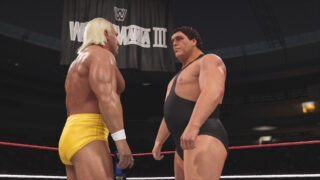WWE 2K24 delivers another solid bout of ringside bliss
2K’s latest entry isn’t a massive overhaul but does improve an already great game
- Creative director
- Lynell Jinks
- Key Credits
- Jeffrey Horn (Art director), Alan Flores (Design director)

“Evolution is a mystery, full of change that no one sees”. So go the lyrics to the theme music for Evolution, one of the WWE’s greatest ever factions.
They’re lyrics that don’t really work in the context of WWE 2K24, however. While this year’s instalment is – as ever – an evolution of last year’s, there’s no mystery involved in pinpointing where the changes have been made.
The most obvious new additions are the three main new match types. Ambulance matches and casket matches don’t differ massively from one another, other than the obvious difference that one traditionally handles the injured while the other holds the dead.
The aim is still the same: players have to weaken their opponents to the point that they can be guided into the ambulance or casket, followed by a button-bashing mini-game (not unlike performing a submission) in which the door is slowly and dramatically closed while the opponent struggles to prevent it.
Both are a perfectly fine addition to the game, even if they’re little more than elaborate submission matches with extra steps. Also welcome is the return of the guest referee match, where the player can choose to control the officials and decide whether to play things by the books or do an Earl Hebner and fix the match, Montreal style.
If you find yourself refereeing a match with CPU competitors, the AI can be pretty shonky. You can turn around out of the blue and deliver a powerbomb to one of them, and as soon as they get up they’ll just continue fighting as if nothing had happened, rather than declare shenanigans.
A meter gauges your corruption level and you’re replaced with a normal ref if you push it too far, but this is easily reset with a couple of accurate pin or count-out counts, allowing you to continue your sinister rule-bending while the goldfish-minded fans and fighters play along. It’s very silly, but fun nevertheless.
The other main change in 2K24 is this year’s Showcase mode. After last year’s John Cena-heavy Showcase which covered the fan favourite’s career, this time the theme is 40 Years of WrestleMania, with a selection of 21 matches spanning the event’s history.
Naturally, this list was always going to spark debate. Ask anyone to list their 21 favourite WrestleMania matches and it’s all but certain no two lists will be the same, but as old fogeys we’d have liked to have seen more matches from the earlier days. The classics like Andre vs Hogan, Savage vs Hogan and Warrior vs… um, Hogan are naturally present and accounted for, but there are plenty of other early gems that don’t feature here (likely due to licensing reasons).
Savage vs Flair from WM8 would have been great, as would Bret vs Owen from WM10, but with the latter fighter in each match-up not present in the game. Similarly, move further down the timeline and the lack of the now AEW-based Edge and Christian means none of their memorable ladder matches with the Hardy Boyz (who are also missing) are featured here.
Again, though, this is down to personal preference and there’s no denying that the matches chosen here are still classics. As in the previous couple of years, the mode makes use of what 2K calls ‘slingshot technology’, in which the game switches to FMV archive footage of the actual match at key points, then switches back to the game. It’s a neat gimmick, but at times the footage goes on far too long, and by the time we reached the recent matches at the end of the timeline we found ourselves skipping the footage to get back to the gameplay quicker.
Another thing Showcase highlights is the game’s admirable attention to detail. Smaller things that may be ignored by other developers are added here because of a knowledge that the fans would be looking for it. Kurt Angle pulling down his leotard straps mid-fight, the Ultimate Warrior’s facepaint running off by the end of his match with Hogan, it’s all here.
“Smaller things that may be ignored by other developers are added here because of a knowledge that the fans would be looking for it. Kurt Angle pulling down his leotard straps mid-fight, the Ultimate Warrior’s facepaint running off by the end of his match with Hogan, it’s all here.”
The final match in Showcase is a bit of a nightmare, but it’s worth trying to beat it because it unlocks extra items for the other main mode, MyFaction. Last year’s MyFaction was criticised for its ridiculously overpriced card packs and its repetitive gameplay, and while this year’s edition doesn’t completely fix everything it’s a big improvement.
The most notable change in MyFaction is a complete overhaul of the Faction Wars mode. In last year’s game this was an endless run of 4-on-4 matches, each of which took an age to beat because of constant interference from CPU opponents every time you tried a pinfall or submission. This has all changed.
This year, Faction Wars has a sort of roguelike structure in which you start with your team of four and have to make your way through five ‘seasons’ of matches, picking up bonus cards and trying to manage your wrestlers’ stamina along the way. You’ll take on a variety of 1-on-1, 2-on-2 and 3-on-3 matches with different rulesets – a ladder match one minute, a tornado tag the next – and there are multiple paths to choose with varying rewards.
At the end of each season you face off against a ‘boss’ faction and it’s back to the 4-on-4 match seen in last year’s Faction Wars, but this time it’s infinitely less frustrating because when a wrestler interferes to break up a pin or submission, they now get an X above their name and are unable to interfere again until they tag in.
This means once all three of your opponent’s partners have interfered, you’re free to pin them without any hassle. It may not be particularly realistic but in terms of actual video game mechanics it’s a hell of a lot less annoying.
The point of Faction Wars is to earn currency, which can then be used to buy wrestlers – either standard ones from a rotating list, or any of the boss faction wrestlers you beat along the way. The latter are more expensive and may require multiple playthroughs to unlock, but they’re exclusive to the mode and help you build your collection level.
The obscenely overpriced card packs make their return this year, and it’s just as comical to consider the possibility of completing a full set of cards without dropping literal thousands on the game. One new addition, however, at least lets you buy specific cards from each pack, meaning that – at least in theory – gone will be the days of blowing all your currency on multiple packs in the hope of getting the one card you want.
This will at least prove potentially useful for future Live Events, which are time-limited and often provide exclusive rewards but sometimes require you to use a specific card which can only be found in packs. If these specific cards can now be bought individually, there’ll be far fewer examples of being locked out of these events due to unlucky loot box picks.
The other big improvement to MyFaction appears to be a reaction to hackers. In last year’s game, MyFaction introduced some special cards with exclusive attires, which could only be used in that mode. Players were angry that those who didn’t care for MyFaction didn’t have access to these new attires, so hackers took the outfits and added them to the game’s Creations mode, so they could be downloaded.
This time, these new attires are called ‘Persona cards’, and once you have a Persona card in your collection they’re added to the game’s main roster as a separate wrestler. For example, we unlocked a special version of Sheamus with the outfit he wore back in 2009 and he then appeared in the main game’s roster as Sheamus 09. The same goes for some of the weirder characters: the action figure version of John Cena is back (and can be unlocked with a Locker Code), and this time he’s a Persona who can be used in other modes.

The odd action figures are another example of the game’s attention to detail. It would have been very easy to slap them into the game as skins for Cena and Rhodes and leave it at that, but each is included in the game as a separate character, with their own bespoke commentary. Select the Rhodes figure, who’s based on Rhodes during his pectoral injury, and the announce team will point out that while he may be made of plastic, the bruise painted on him still looks painful.
All of this is well and good but none of it is exactly revolutionary. Last year’s MyFaction mode has obviously been winding down now so if that was your main mode then moving to WWE 2K24 is practically a necessity.
If, however, you’re the sort of person who doesn’t bother with MyFaction or Showcase and mainly plays WWE 2K23 to have local matches with your friends, the differences here will be far fewer (the new match types aside).
There’s an argument to be made, then, that anyone who’s perfectly happy to continue playing WWE 2K23 with their friends can do so without missing out on too much. However, there can be no denying that where changes have been made, they’re almost all positive.
While are no groundbreaking changes to upend the WWE series this year, the additions and improvements which have been made are positive ones, making the game another solid entry in a series that is now clearly out of its rut.
- MyFaction content is far less repetitive
- New match types are a welcome addition
- Superb attention to detail
- Tag interference issue has been mercifully addressed
- Too much mid-match FMV ruins Showcase mode
- MyFaction still remains a grind





















